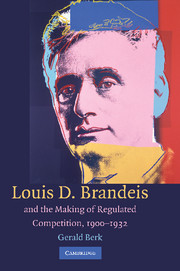Book contents
- Frontmatter
- Contents
- Figures and Tables
- Acknowledgments
- 1 Creative Syncretism
- PART I BRANDEIS AND THE THEORY OF REGULATED COMPETITION
- PART II REGULATED COMPETITION IN PRACTICE
- 5 Cultivational Governance at the Federal Trade Commission
- 6 Deliberative Polyarchy and Developmental Associations
- 7 From Collective Action to Collaborative Learning: Developmental Association in Commercial Printing
- PART III REGULATED COMPETITION CONTESTED
- PART IV CONCLUSION
- Appendix Industries and Number of Associations with at Least Substantial Involvement in Developmental Association, by Industry Group
- Index
7 - From Collective Action to Collaborative Learning: Developmental Association in Commercial Printing
Published online by Cambridge University Press: 23 November 2009
- Frontmatter
- Contents
- Figures and Tables
- Acknowledgments
- 1 Creative Syncretism
- PART I BRANDEIS AND THE THEORY OF REGULATED COMPETITION
- PART II REGULATED COMPETITION IN PRACTICE
- 5 Cultivational Governance at the Federal Trade Commission
- 6 Deliberative Polyarchy and Developmental Associations
- 7 From Collective Action to Collaborative Learning: Developmental Association in Commercial Printing
- PART III REGULATED COMPETITION CONTESTED
- PART IV CONCLUSION
- Appendix Industries and Number of Associations with at Least Substantial Involvement in Developmental Association, by Industry Group
- Index
Summary
Was collaborative learning successful? Did it channel rivalry from cutthroat competition over volume into improvements in products and production processes? Did benchmarking perturb habits and spark inquiry? Did collaborative learning circumvent collective action problems? What exactly was the FTC's role in establishing and diffusing collaborative learning? This chapter addresses these and other questions through a case study of the commercial printing industry.
Commercial printers were pioneers in developmental association. In 1909, they launched the American Printers Cost Commission to develop a uniform cost accounting system. Two years later the United Typothetae of America (UTA) took up the commission's work. After a year of work, the UTA completed its first Standard Cost System; by 1913, it distributed its first benchmarking data to commercial printers. Cost work had positive effects on the UTA. Membership tripled, local chapters bloomed, and hundreds of printers adopted the cost system. But progress stalled in 1916 and UTA leadership turned to the state, where they found helpful encouragement from the Federal Trade Commission. Armed with a fresh sense of public purpose, the UTA launched a three-year organizing campaign in 1918. By the early 1920s, one-third of all commercial printers in the United States were using the standard cost system and many of those were actively benchmarking. The result was to end cutthroat price competition in many cities, increase product diversity, augment labor skills, advance technological innovation, treble productivity, and increase industrial fragmentation. Collaborative learning was successful in commercial printing.
- Type
- Chapter
- Information
- Publisher: Cambridge University PressPrint publication year: 2009



